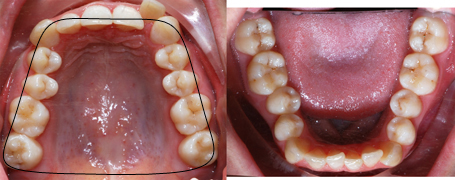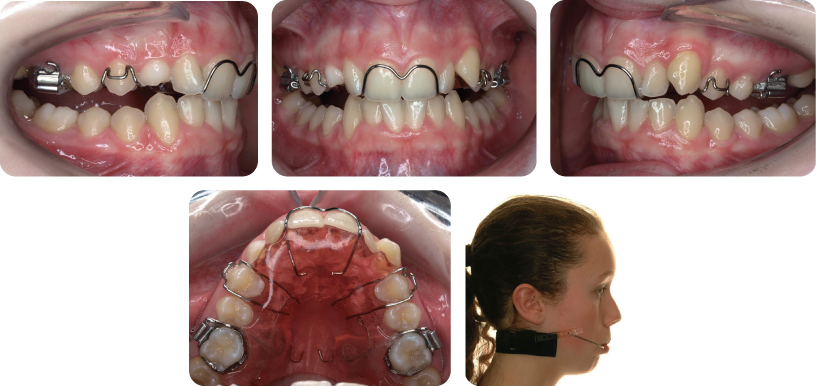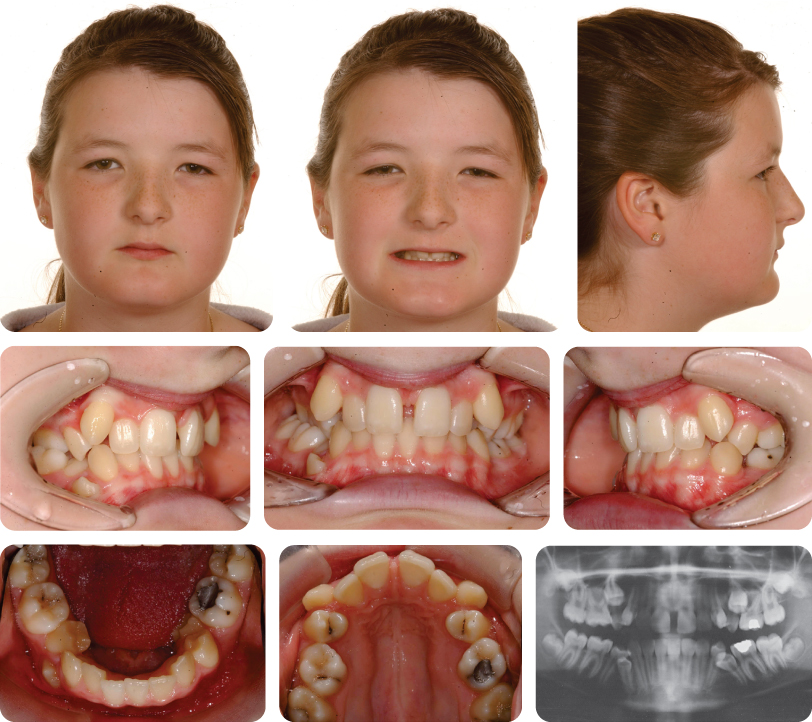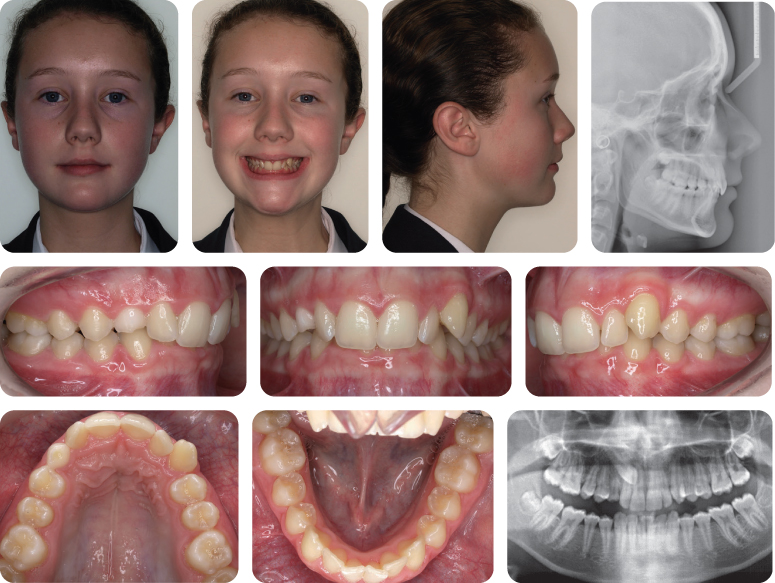class ii division 2 subdivision
The discrepancy between the upper and lower teeth does not match the discrepancy between the upper and lower teeth where the molars and canines are located red and blue arrows. Cdeviation of the mandible on closure.

Class Ii Division 2 Dr Sylvain Chamberland Orthodontiste
The upper incisors were upright and the lower incisors normally inclined.

. Typically there is an increased and complete overbite. With these clarifications the patient decided to undergo orthodontic treatment to improve his dental occlusion and affirmed that he was fully aware that orthodontic treatment could have no effect in his clicking and. 3 Mandibular plane to Frankfurt horizontal angle.
Class II location groups are determined by. Class II subdivision represents 50 of all Class II malocclusions with responsible primary factor being a deficient mandible caused by either a reduced height of the ramus or a reduced length of the mandibular body on the side of the Class II. Class II Division 2.
Class 2 Division 2 also commonly written with a Roman numeral Class ii Division 2 represents an area where combustible dust may be. THIS MAY BE THE RESULT OF A asevere closed bite condition. Both arches exhibited mild-to-moderate crowding.
Or Zone 22 locations whichever is applicable as shown in Figure 5165 D 4. 4 Overjet 4 mm. However it was also explained that Class II Division 2 subdivision left and anterior deep overbite are contributing factors to increase the pain and discomfort in TMJs.
BClass II Division 1 malocclusion. A class II division 2 malocclusion is a subdivision of the Angle class II classification and is defined by a class II division 2 incisor relationship with the incisal edges of the mandibular incisors occluding posterior to the cingulum plateau of the maxillary central incisors which are retroclined. For the Class II Division 2 subdivision group included.
The results showed that 6136 had type 1 1818 had type 2 Class II subdivision malocclusion and 2045 had mixed characteristics. Class II division 2. Class II Division 2 subdivision left malocclusion associated with anterior deep overbite in an adult patient with temporomandibular disorder The orthodontic treatment of patients with chief complaint of temporomandibular disorders TMD presents doubtful prognosis due to the poor correlation between malocclusions and TMDs.
Where automated spray application equipment is used the area outside the access doors shall be unclassified provided the door interlock. 2 Maxillary central incisor to Sella-Nasion line. Note that the dust must be present in sufficient quantities for a fire or explosion hazard to exist.
Brezniak 8 identifiedpathognomonic cephalometric. Class II locations are those that are hazardous because of the presence of combustible dust. The upper incisors are tipped backward and hide the fact that.
A 10-YEAR-OLD PATIENT SHOWS A DISCREPANCY IN THE MIDLINES OF MAXILLARY AND MANDIBULAR DENTITIONS IN OCCLUSION. Several articles have investigated and discussed the development of this asymmetric molar relationship in Class II subdivision cases28 According to results derived from two-dimensional imaging studies most Class II subdivision malocclusions are dentoalveolar in origin while a skeletal contributiondue to an asymmetric mandibleseems to exist in only. The treatment objectives were the correction of Class II Division 2 subdivision left anterior deep overbite dental midline deviations and crowding.
CClass II Division 1 Subdivision. Prologue Patients with Class II subdivision malocclusions have Class I characteristics on one side and Class II characteristics on the other primarily because of the distal positioning of the mandibular first molar in relation to the maxillary first molar on the Class II side. Class II division 2 According to Angles classification.
Class II division 2. Thus the aim of this case report is to present dentoalveolar and fac. It is when the buccal groove of the first mandibular molar occludes distal to the mesiobuccal cusp of the first maxillary molar with retroclination of the maxillary central incisors.
The largest category was mandibular asymmetry. We offer a comprehensive solution service which includes extrusion design manufacture software programming and project management support. Class II Division 2 Subdivision Malocclusion in an Adult Patient treated with the Forsus Fatigue-resistant Device placed.
1 All of the above criteria as stated for the Class II1 group. Class II subdivision malocclusion types and evaluation of their asymmetries. The area within 915 mm 3 ft of any opening shall be classified as Class I Division 2.
Both arches exhibited mild-to-moderate crowding. Class II subdivision malocclusions were grouped into 3 main categories. Class I Zone 2.
In most patients with Class II subdivision malocclusion the maxillary dental midline is. BClass II Division 1. The fact that there is some combustible dust present does not mean a Class II hazardous location exists.
DClass II Division 2. The predominant asymmetric dentoalveolar characteristics of both types of Class II subdivision malocclusions were evident when individually compared with a normal. Malocclusion Angle class II subdivision 710782002 Definition A distal placement of the mandibular molar a mesial relationship of the maxillary or a combination of the two.
The class II division 2 differs from division 1 by the following characteristic. Interesting trends were noted with regard to treatment strategies midline and molar corrections and mandibular incisor proclination. A Class II division 2 malocclusion was associated with a severe overjet and 100 deep bite due to moderately supraerupted upper incisors and excessively supraerupted lower incisors.
Treatment of Class II subdivision malocclusion is challenging and orthodontists frequently struggle to determine the choice of treatment. We have experience in large turnkey solutions for Class 1 Division 2 and ATEX Zone 2 environment projects be sure to give us a call 44 0 1785 879 050 UK or 1 864 421 6991 US to discuss yours. The ignition temperature of the dust the electrical conductivity of the dust and the thermal blanketing effect the dust can have on heat-producing equipment such as lighting fixtures and motors.
A class II division 2 malocclusion is a subdivision of the Angle class II classification and is defined by a class II division 2 incisor relationship with the incisal edges of the mandibular incisors occluding posterior to the cingulum plateau of the maxillary central incisors which are retroclined. Class II locations are divided into three groups EFG. When explaining to the patient what his orthodontic problems were it was pointed out that according to the current literature evidence there was no guarantee that the correction of his.

Class Ii Division 2 Subdivision Malocclusion In An Adult Patient Treated With The Forsus Fatigue Resistant Device Placed Unilaterally Antelo Om Bosio Ja Saga Ay Meira Tm Tanaka Om Contemp Clin Dent

Just A Long View Shot Model Trains Miniature House Model Railroad

Large Preview Of 3d Model Of Geodesic Catalog Class Ii Geodesic Geodesic Dome Polyhedron

5 Class Ii Division 2 Malocclusion Pocket Dentistry

Sports Teams Banners Posters Gallery Shirk Photography World Renowned Iowa Portrait Studio Sports Team Banners Sports Team Photography Soccer Team Pictures

Pdf Class Ii Division 2 Subdivision Left Malocclusion Associated With Anterior Deep Overbite In An Adult Patient With Temporomandibular Disorder Semantic Scholar

Pony Through Plate Girder Bridge Over 7th Street S On Canadian National Railway Model Trains Toy Train Layouts Trains For Sale

Class Ii Division 2 Dr Sylvain Chamberland Orthodontiste

5 Class Ii Division 2 Malocclusion Pocket Dentistry
Class Ii Division 2 Subdivision Left Malocclusion Anterior Deep Bite And Tmd

Pdf Treatment Of Class Ii Division 2 Malocclusion With Miniscrew Supported En Masse Retraction Is Deepbite Really An Obstacle For Extraction Treatment Semantic Scholar

5 Class Ii Division 2 Malocclusion Pocket Dentistry

Class Ii Division 2 Subdivision Malocclusion In An Adult Patient Treated With The Forsus Fatigue Resistant Device Placed Unilaterally Antelo Om Bosio Ja Saga Ay Meira Tm Tanaka Om Contemp Clin Dent

Class Ii Division 2 Subdivision Malocclusion In An Adult Patient Treated With The Forsus Fatigue Resistant Device Placed Unilaterally Antelo Om Bosio Ja Saga Ay Meira Tm Tanaka Om Contemp Clin Dent

North Dakota Alerus Center Football Championship Subdivision University Of North Dakota Football Stadiums North Dakota Football

Pin On Southern Railway Of British Columbia

Pdf Class Ii Division 2 Subdivision Left Malocclusion Associated With Anterior Deep Overbite In An Adult Patient With Temporomandibular Disorder Semantic Scholar

